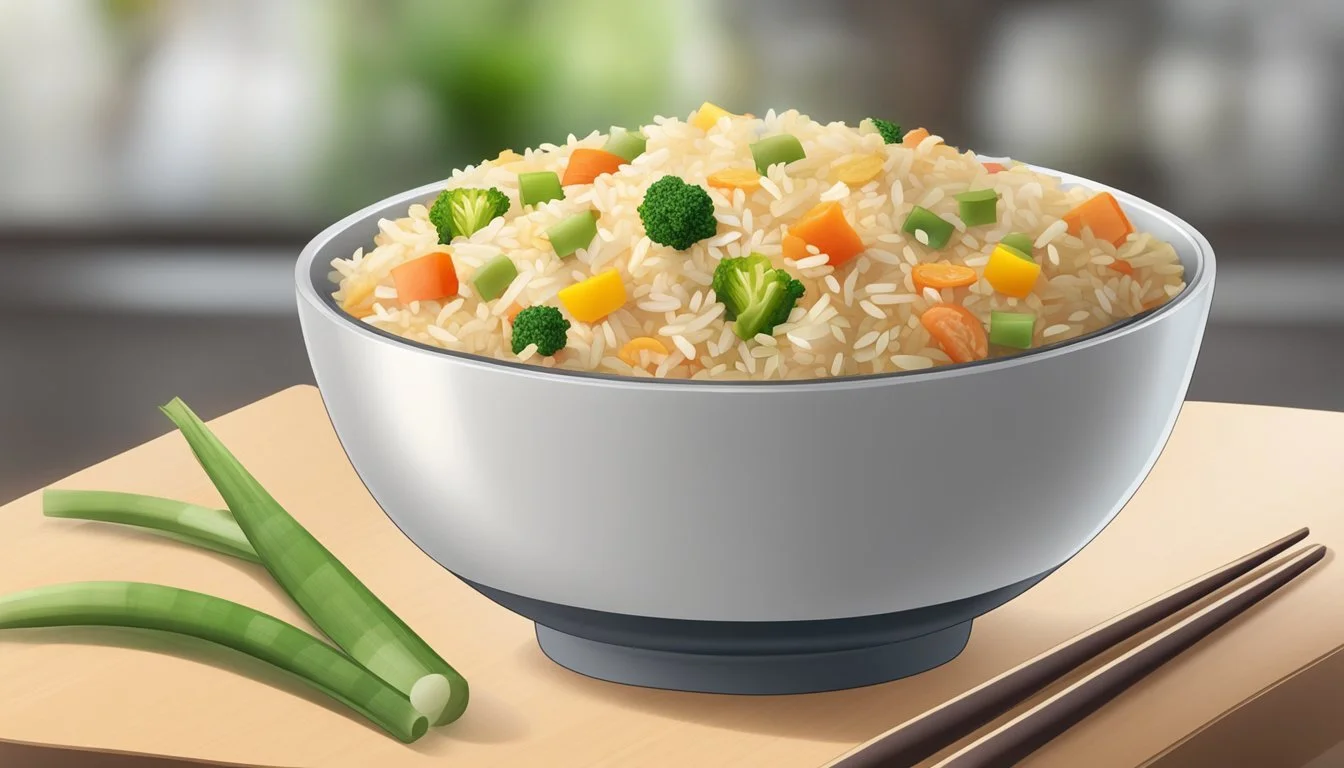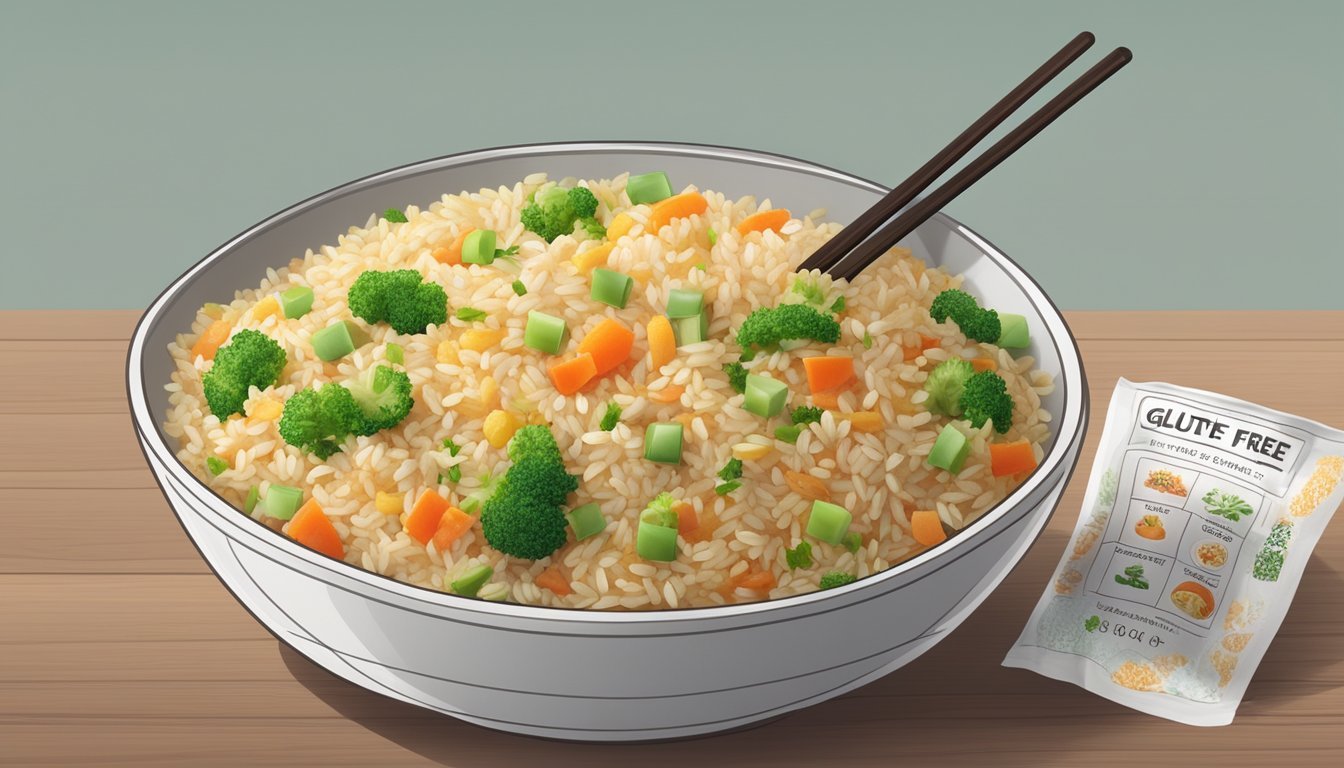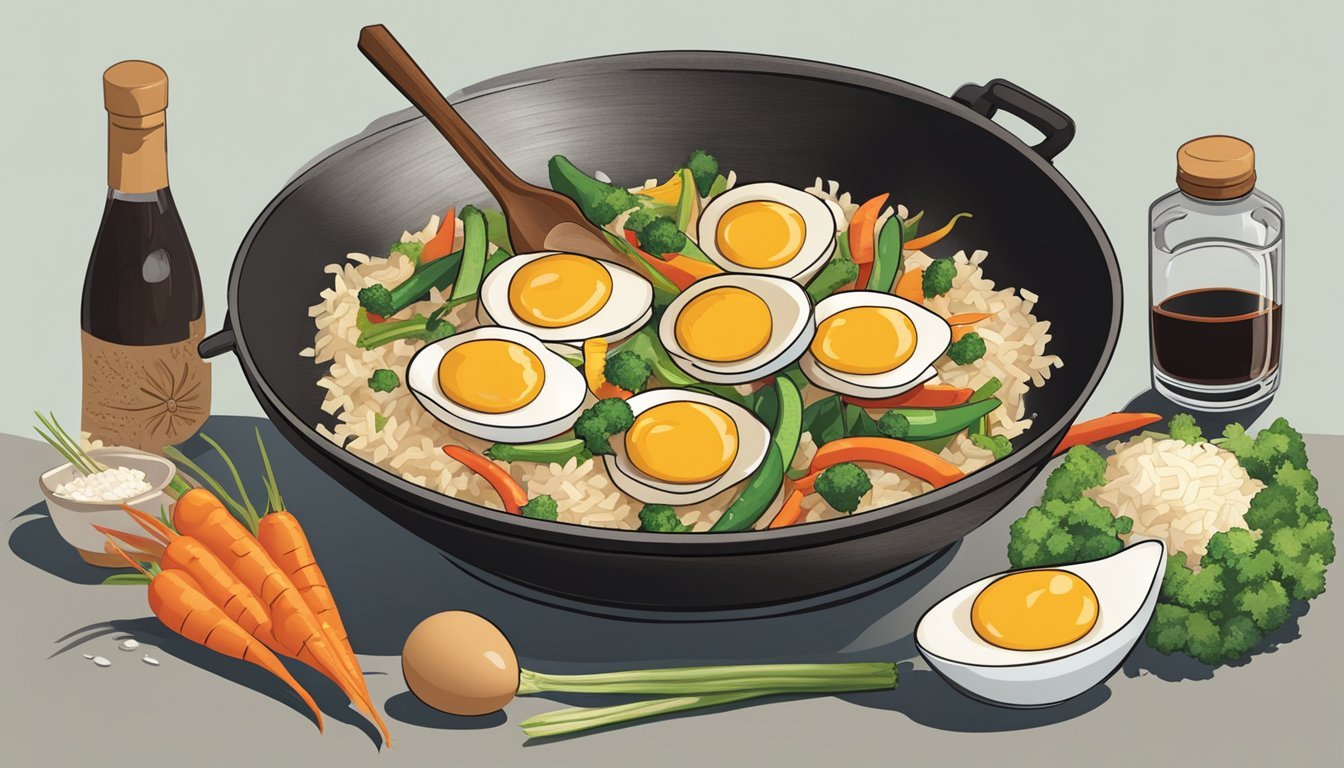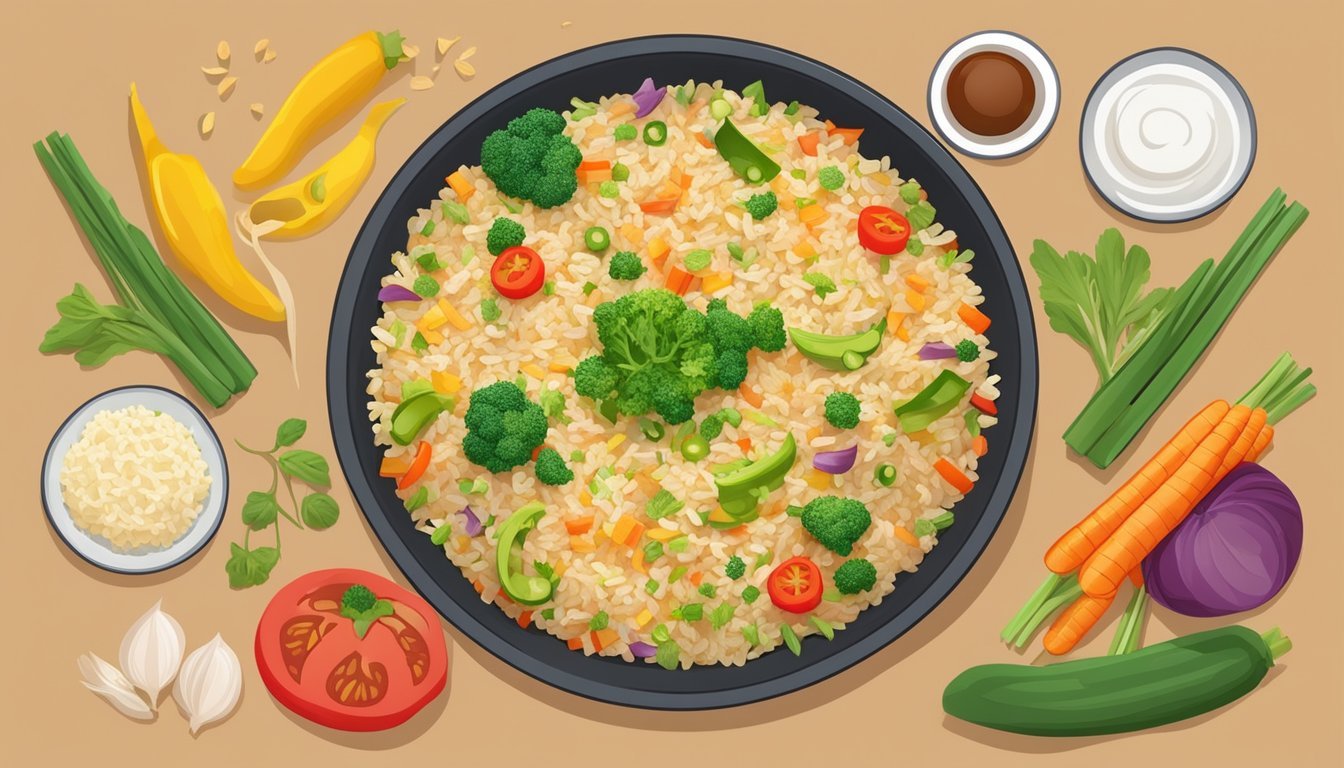Is Fried Rice Gluten-Free?
Unveiling the Truth About This Popular Dish
Fried rice is a staple dish in many Asian cuisines, renowned for its savory flavors and the ease with which it can be customized. Traditionally made by stir-frying cooked rice with ingredients like vegetables, eggs, and meats, it's a versatile meal that can be enjoyed for lunch or dinner. However, for individuals with celiac disease or those following a gluten-free diet, the question arises: is fried rice gluten-free?
The primary concern regarding gluten in fried rice is not the rice itself but the additional ingredients that are often included in the recipe. Rice is naturally gluten-free, making it a safe choice for those avoiding gluten. Nonetheless, fried rice is commonly prepared with soy sauce and other seasonings, which can contain wheat and therefore gluten. It's imperative to scrutinize the ingredients used in fried rice, especially when dining out, as kitchens may use soy sauce with wheat or cook dishes in an environment where cross-contamination with gluten is possible.
To ensure fried rice is gluten-free, every component must be free of gluten-containing substances. This includes using gluten-free soy sauce or tamari and confirming that any processed garnishes or mixed ingredients are certified gluten-free. When these precautions are taken, individuals with gluten sensitivities can enjoy fried rice without concern, provided the cooking environment is also mindful of avoiding cross-contamination with gluten.
Understanding Gluten
The presence of gluten in food is a significant concern for individuals with celiac disease or gluten sensitivity. This section breaks down what gluten is, identifies the grains it's found in, and discusses how it affects those with certain health conditions.
What Is Gluten?
Gluten is a protein composite primarily found in wheat, barley, and rye. It’s the substance that gives dough its elastic texture and helps breads to rise by trapping gas produced during fermentation. Gluten is ubiquitous in many products due to its desirable properties in food production.
Gluten-Containing Grains
Not all grains contain gluten. Here is a list of grains that do:
Wheat
Barley
Rye
Triticale (a cross between wheat and rye)
These grains are often used in breads, pastas, cereals, and many processed foods. Hence, individuals must read labels carefully to avoid gluten.
Celiac Disease and Gluten Sensitivity
Celiac disease is an autoimmune disorder wherein ingestion of gluten leads to damage in the small intestine. It affects approximately 1% of the population. Gluten sensitivity, or non-celiac gluten sensitivity (NCGS), describes those who experience symptoms similar to celiac disease without the intestinal damage. Symptoms can include gastrointestinal issues, headaches, fatigue, and joint pain. For individuals with celiac disease or gluten sensitivity, avoiding gluten is essential to manage symptoms and health.
The Basics of Fried Rice
Fried rice is a versatile dish commonly found in various cuisines around the world. While its origins are often traced back to Chinese culinary traditions, it has since taken on many regional variations. The essence of fried rice lies in its ability to transform leftover rice into a flavorful and satisfying meal by incorporating a combination of ingredients and spices through specific cooking techniques.
Traditional Fried Rice Ingredients
Traditional fried rice starts with a base of cooked rice that has been previously cooled. The rice is typically a long-grain variety like jasmine or basmati, which helps in preventing the dish from becoming too sticky. Next, eggs are scrambled and mixed into the rice, contributing protein and a rich texture. Vegetables like carrots, peas, and onions are often included for their nutritional value and to add a crunchy dimension to the dish.
A crucial element in fried rice is the oil used for cooking; it not only prevents sticking but also imparts a distinct flavor. Commonly, chefs will utilize a wok, which is a round-bottomed cooking vessel, to achieve a quick and even fry. For seasoning, soy sauce is a staple condiment that provides saltiness and a depth of umami. Notably, the presence of soy sauce or other sauces containing gluten determines whether the fried rice is gluten-free or not.
Main ingredients:
Cooked, cooled rice (usually long-grain like jasmine or basmati)
Scrambled eggs
Chopped vegetables (e.g., carrots, peas, onions)
Common additional ingredients:
Protein (chicken, shrimp, or beef)
Aromatics (garlic, ginger)
Oil (sesame oil, olive oil)
Sauce (soy sauce, oyster sauce)
Common Cooking Methods
The method of cooking fried rice requires high heat and rapid stirring to achieve the signature texture and prevent the rice from clumping. A wok is ideal because of its shape, creating a hot zone at the bottom where the cooking begins and cooler sides where ingredients can rest briefly during the process. Chefs typically add the oil to the wok first, followed by the rice and then vegetables and other ingredients in quick succession. The eggs may be scrambled separately and then incorporated or cooked within the wok alongside the rice. Continuous stirring is vital to ensure even cooking and to integrate all the flavors fully.
The cooking technique can vary slightly to accommodate different textures or ingredients. For instance, in some variations, chefs cook the heavier proteins first, set them aside, and then add them back just before the dish is finished to avoid overcooking. The use of seasoning, particularly soy sauce, is done usually towards the end of the cooking process to prevent the rice from becoming soggy and to evenly distribute the flavor.
Identifying Gluten in Fried Rice
When assessing whether fried rice is gluten-free, one must scrutinize the individual ingredients and consider the preparation environment for potential gluten presence.
Soy Sauce and Gluten
Soy sauce is a common ingredient in fried rice that typically contains gluten due to wheat fermentation during its production process. For a gluten-free alternative, one should opt for:
Gluten-free soy sauce
Tamari sauce, usually gluten-free but always verify labels
Coconut aminos, a naturally gluten-free soy sauce substitute
Cross-Contamination Risks
Cross-contamination occurs when gluten-free food comes into contact with gluten-containing substances. This is especially a concern in restaurants or kitchens where utensils and cookware are shared between dishes. To mitigate this risk:
Use separate cooking equipment
Ensure workspace cleanliness prior to preparing gluten-free fried rice
Verbally confirm with restaurants their cross-contamination prevention practices
Hidden Gluten in Condiments
Several condiments added to fried rice for enhanced flavor, such as oyster sauce and pre-prepared spice mixes, often harbor gluten. It's crucial to read labels and seek specifically labeled gluten-free options. Watch out for:
Oyster sauce: Choose varieties that specify gluten-free on the packaging.
Broth powders: These may include wheat-based ingredients.
Marinades: Hidden gluten can be found here as well, always read ingredient lists carefully.
Making Gluten-Free Fried Rice
When preparing gluten-free fried rice, attention must be paid to the selection of appropriate gluten-free ingredients, including the right type of rice, soy sauce alternatives, and additional components that ensure the dish remains safe for those with gluten sensitivities or celiac disease.
Choosing the Right Rice
The foundation of any fried rice dish is the rice itself. For a gluten-free fried rice recipe, one should opt for plain rice varieties, as they are naturally gluten-free. Long-grain rice such as Jasmine or Basmati is preferred for its fluffy and less sticky texture after cooking. It's important to ensure the rice is not contaminated with gluten-containing grains during processing. The rice should be cooked and cooled prior to frying to prevent clumping.
Gluten-Free Soy Sauce Alternatives
Soy sauce is a staple in fried rice, providing the savory umami flavor. Traditional soy sauce contains wheat and thus gluten. Gluten-free alternatives include:
Tamari: A Japanese soy sauce that is usually made without wheat, but one should always check the label to confirm it's labeled as gluten-free.
Gluten-free labeled soy sauce: Some brands specifically produce a gluten-free soy sauce variant.
Liquid aminos: A wheat-free option that also imparts a similar umami flavor.
Here's a breakdown of the alternatives:
Alternative Gluten Content Suitable for Gluten-Free Diet Traditional Soy Sauce Contains Wheat No Tamari Wheat-Free Yes, if labeled gluten-free Gluten-Free Soy Sauce Gluten-Free Yes Liquid Aminos Wheat-Free Yes
Additional Gluten-Free Ingredients
To enrich gluten-free fried rice, a variety of additional ingredients can be included, such as:
Eggs: Scrambled eggs are a gluten-free protein addition to fried rice.
Cooking Oil: Vegetable oil or sesame oil are both gluten-free and can be used for frying. Sesame oil adds a nutty flavor to the dish.
Vegetables: Carrots, peas, bell peppers, and onions are commonly used, providing texture and nutrition without any gluten concerns.
Proteins: Beyond eggs, one may include chicken, shrimp, or tofu — all of which are gluten-free.
Seasonings: Salt, pepper, and gluten-free spices can be used to enhance the flavor.
All ingredients should be checked to ensure that they do not contain gluten or haven't been cross-contaminated with gluten-containing products.
Gluten-Free Fried Rice Variations
Gluten-free fried rice is versatile, accommodating a variety of dietary preferences without sacrificing flavor. The key is selecting safe, gluten-free ingredients that complement the rice.
Vegetarian and Vegan Options
Vegetarians and vegans can enjoy gluten-free fried rice by omitting animal proteins and ensuring any sauces used, like soy sauce, are gluten-free. Tofu, a soy-based protein, is an excellent substitute for meat and can be pan-fried until golden before being added to the rice.
Tofu Prep: Pressed and cut into cubes
Stir Fry: Use gluten-free oil; sauté with peas and carrots
Protein Choices
When adding protein to gluten-free fried rice, one must ensure that the chosen meats or seafood are not marinated or prepared with gluten-containing ingredients. Chicken, pork, or shrimp are popular options, often stir-fried separately and then combined with the rice.
Chicken: Boneless, seasoned with salt and pepper
Shrimp: Peeled and deveined
Pork: Cut into small pieces, ensure no added gluten
Vegetable and Flavor Additions
Vegetables and aromatics play a critical role in enhancing the dish's complexity and nutritional value. Key gluten-free additions include green onions, ginger, garlic, and onions. These ingredients should be finely chopped and sautéed to release their full flavor before being mixed with the rice.
Essential Veggies: Diced carrots, peas, thinly sliced green onions
Aromatics: Minced garlic, ginger, and chopped onions
Flavor Enhancers: Ensure all condiments, like gluten-free soy sauce and sesame oil, are labeled gluten-free
Tips for Cooking Gluten-Free Fried Rice at Home
When making gluten-free fried rice at home, one should focus on proper equipment, technique, and storage methods to ensure the dish remains free from gluten and delicious.
Cooking Equipment
Wok: Utilizing a wok is ideal for stir-frying rice because its shape allows for easy tossing and even cooking. A well-seasoned cast iron wok adds a distinct flavor but must be carefully maintained to be gluten-free.
Frying Pan: A non-stick frying pan can be a good alternative if a wok isn't available. Ensure it hasn't been used to cook gluten-containing foods to avoid cross-contamination.
Cast Iron Skillet: A cast iron skillet is another suitable option for making fried rice. It retains heat well, ensuring even cooking. Prior to use, clean the skillet thoroughly to avoid gluten residue.
Cooking Techniques
High Heat: Use high heat to cook the rice swiftly, giving it a characteristic texture and preventing it from becoming mushy. Stir-frying on high heat also helps ingredients like vegetables retain their crispness.
Add Ingredients Sequentially: Hard vegetables such as carrots should be added before softer ones like peas to ensure even cooking. Introduce ingredients like gluten-free soy sauce towards the end to avoid overcooking.
Constant Stirring: Keep the ingredients moving. Constant stirring is crucial in stir-fry cooking to prevent sticking and to achieve a uniform distribution of flavors and heat.
Storing and Reheating
Refrigeration: Store leftover fried rice in an airtight container within two hours of cooking to prevent bacterial growth. Refrigerated cooked rice can be stored for up to four days.
Reheating: To reheat, one can use a pot or a frying pan on the stove with a bit of water or additional oil to prevent drying out. Stir constantly to ensure even reheating and restore the dish's original flavor and texture.
By adhering to these tips, one can confidently prepare gluten-free fried rice that is both safe for those with gluten sensitivities and enjoyable for all.
Gluten-Free Fried Rice in Restaurants
When seeking gluten-free fried rice in restaurants, diners should be aware that not all establishments cater to the specific needs of those with gluten sensitivities or celiac disease. Ensuring that the fried rice is genuinely gluten-free requires both vigilance and clear communication.
Eating Out Safely
Restaurants vary in their understanding of gluten-free requirements, especially when it comes to a dish as commonly modified as fried rice. Diners must be cautious of cross-contamination, an issue that can occur when the same kitchen tools or cooking areas are used for both gluten-free and gluten-containing foods. Some Chinese or Asian-themed restaurants might offer gluten-free soy sauce as an alternative, yet there is always a risk of gluten exposure if the kitchen is not exclusively gluten-free.
To safely eat gluten-free fried rice at a restaurant, diners should look for establishments that:
Explicitly advertise a gluten-free menu
Employ knowledgeable staff who are aware of cross-contamination risks
Use gluten-free sauces and seasonings for their fried rice
Offer clear labeling on their menu regarding which dishes are gluten-free
Questions to Ask at Restaurants
When ordering fried rice, individuals should directly ask restaurant staff the following specific questions to ensure a safe dining experience:
Is there a dedicated gluten-free cooking space in the kitchen?
Are the ingredients used in the fried rice certified gluten-free?
Which brand of soy sauce or alternative seasonings are used, and are they gluten-free?
Can the kitchen staff accommodate special requests to prevent cross-contamination?
By obtaining clear answers to these questions, diners can make informed decisions on where and what to eat when in pursuit of gluten-free fried rice outside their home.
Gluten-Free Products and Brands
When looking for gluten-free options, it's crucial to select products that are specifically labeled as gluten-free. For individuals with celiac disease or gluten sensitivity, this is particularly important due to potential cross-contact with gluten during processing.
Gluten-Free Rice Brands
Certain brands have established themselves as reliable providers of gluten-free rice. Lundberg Family Farms is known for a variety of gluten-free rice products, including white, brown, and specialty rices. Their packaging is clearly labeled to ease the selection process for consumers. Similarly, Minute Rice offers gluten-free options that are quick and convenient, catering to those who need time-efficient meal solutions without compromising on their gluten-free needs.
Certified Gluten-Free Sauces
The use of sauces in fried rice can often introduce gluten, hence it’s paramount to choose gluten-free certified sauces. For soy sauce alternatives, Gluten-Free Soy Sauce brands have crafted sauces without wheat ingredients, ensuring they're safe for gluten-free diets. Tamari Sauce, a wheat-free alternative to traditional soy sauce, is often naturally gluten-free. However, one should still look for bottles that are labeled as certified gluten-free. Brands to consider include San-J, which offers a variety of Gluten-Free Tamari sauces that can be used confidently in gluten-free cooking.
Conclusion
In determining the gluten-free status of fried rice, one must consider the ingredients and preparation methods. Gluten-free fried rice is not only possible but can retain the rich flavor that this dish is known for, provided that all ingredients are gluten-free.
Typical ingredients include:
Rice: Naturally gluten-free
Proteins: Chicken, shrimp, or tofu, usually gluten-free
Vegetables: Carrots, peas, onions, etc., also gluten-free
Eggs: Used in most recipes and are gluten-free
Sauces: Soy or oyster sauces often contain gluten; opt for labeled gluten-free versions
Cross-contamination is a risk to consider, especially when dining out. Cooking fried rice at home gives one control over the ingredients and cooking environment, enhancing its gluten-free integrity.
For those with celiac disease or gluten sensitivity, scrutinizing each component is critical. It's advisable to cook with gluten-free certified products and to confirm the absence of gluten when sourcing ingredients.
Here's a simplified gluten-free recipe structure for homemade fried rice:
Start with cooked, cooled rice to avoid clumping.
Use gluten-free soy sauce or a suitable alternative like tamari.
Add proteins and vegetables, sautéing until properly cooked.
Incorporate eggs, scrambling them within the rice mixture.
Season as desired with salt, pepper, and gluten-free spices.
By adhering to these guidelines, one ensures a safe, delicious gluten-free fried rice experience.







